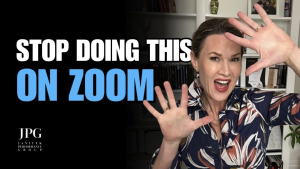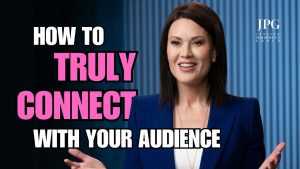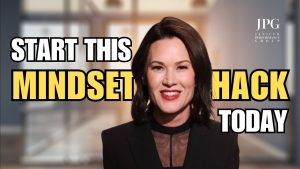This is an emotional time.
We could be approaching WWIII, and you might be feeling many things intensely.
This morning, I’m sitting in a hotel room getting ready to help clients present on stage during their annual meeting, and it’s hard not to be distracted by the news.
If you’re in a high-pressure job, you need to be “on” despite everything happening around you. Maybe you’re coming out of a tense finance meeting or just performed surgery – and you need to lead a webinar or do a keynote.
It could also be personal. You could have a sick child, or you just finished helping your parent move into a care facility.
You need to be “on” to be the leader your team needs, but you’re not sure how you’re going to keep going forward and commanding the room–be it on Zoom, in a conference room, or auditorium packed with 5,000 people. The audience will know if you’re not 100% present.
Why mindset is key to being a great communicator
The key to being a great communicator is the right mindset. I’ll be talking about that every week–empowering you to show up as the leader you are or aspire to become.
First up, let’s talk about overall wellness. While I’m not a medical expert, many of my clients are physicians – and I listen closely. Plus, I know firsthand what happens when I don’t take care of myself.
Here are my three tips that I train my clients to follow – and that I try to practice every day:
Exercise → Get out all that nervous energy. You will not be motivational, inspirational, or present if you have all the unneeded nervous energy going on in your head. Some of the most prominent thought leaders I train exercise each day. They know the science behind it and have felt their lives drastically improve because of it.
Especially on days when you’re performing in front of an audience – walk your dog, hit the Peloton, or do yoga. It doesn’t have to be a 45 minute HIIT class. It just has to be something that gets out the extra anxious energy each morning. Even better if you can add at least five minutes on a meditation app.
Stop sugar → Lower your anxiety. I train people worldwide, and the one thing that gets the most grunts from audiences is when I mention avoiding inflammatory foods. They just can’t handle it. Some of the most successful people I work with changed their lifestyles and now perform at a much higher level.
Sugar causes inflammation in your body. More inflammation leads to more anxiety (and a host of other issues like dementia). Curb your inflammation, and you’ll have less brain fog and anxiety – and become a more inspirational thought leader. If you’re anxious about world events or something going on personally – it’s even more important to cut out inflammatory foods.
Breathe → Slow down and make others less anxious. Sometimes we breathe more rapidly when we’re nervous, making our audiences anxious. If we relax and change our mindsets — we put our audiences at ease, and they’re more likely to trust our information. Before you walk on stage or start an online webinar, take a deep breath to reduce your cortisol levels and lower your heart rate. But let’s be very specific here. It’s a deep breath in from your nose, and then a longer exhale out of your nose. Do not fall prey to rapid breathing. Slow it down.
Look up these two experts for the science behind it: James Nestor and Wim Hof. I’m grateful that my personal trainer introduced me to this. It’s helped me personally and professionally. I can handle intense situations much better now.
Why mindset is only part of the solution
Doing those three simple things every day will empower you to show up with more focus, clarity, and energy. But that’s only half the battle when it comes to amplifying your thought leadership.
We also need to talk about the specific tactics to keep your audience and make sure they remember your messages. I address that in my weekly newsletter focused exclusively on public speaking and media interview tips. To get the next issue in your inbox, subscribe here.
These are hard times. Your team needs you to be a leader now. But, to be there for them, you must take care of yourself first. I’ll be back next week with more tips for strengthening your mindset so you can communicate with power no matter the situation.
P.S. Want more tips? Be sure to sign up for my LinkedIn newsletter where you’ll get exclusive tips on strengthening your mindset to become a better communicator. Click here to subscribe to Thought Leaders Amplified on LinkedIn.
P.P.S. I created a training for health care professionals who need to discover their message and story, deliver it clearly, succinctly, and confidently, and present in a way that intrigues, entertains and keeps the audience’s attention. Share it with your friends in health care. Check it out even if you’re not in health care. The tips and tricks are universal. Click here to learn more.
P.P.P.S. Whenever you’re ready… here are three more ways I can help you build your brand, own your voice, and stand out:
- Want more tactical advice you can implement today? Check out my blog here for great articles, stories, and lessons I’ve shared over the years.
- Looking for one-on-one coaching or a consultation with me? Schedule a complimentary call here to speak to our team about how we can help you.
- Follow me on Instagram here for more media and public speaking tips, videos… and a little fun.












